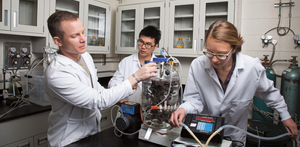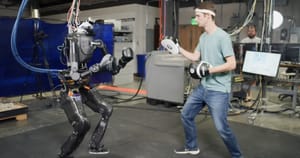Researchers at Columbia University are flexing their soft actuator muscles (pun slightly intended) with a groundbreaking development in soft robotics.
They've created a new synthetic muscle inspired by nature, boasting impressive capabilities in terms of strength, flexibility, and resilience.
This advancement pushes the boundaries of soft robotics, a field dedicated to robots made from compliant materials rather than rigid skeletons.💪🤖
Soft robotics is an emerging field that focuses on creating robots from compliant materials rather than rigid components. These robots can mimic the flexibility and adaptability of living organisms, making them ideal for a wide range of applications. The use of soft materials in robotic systems represents a significant advancement, allowing for safer, more versatile, and more efficient robots. [TAG CLONE ROBOTICS]
Why Soft Robotics Matters
Unlike their metal counterparts, soft robots can mimic the flexibility and adaptability of living organisms. Soft materials allow robots to navigate complex environments, perform delicate tasks, and interact safely with humans.
Think of Baymax, the large Disney soft robot, is this a step closer to more human like and comforting humanoids? From medical applications to industrial automation, soft robots have the potential to revolutionize various sectors.
Traditional Rigid Actuators and Their Limitations
Traditional rigid actuators, such as electric motors and hydraulic systems, have been the backbone of robotic systems for decades. These actuators are known for their precision and strength, making them ideal for tasks requiring high power and control.
However, they come with significant limitations: - Lack of Flexibility: Rigid actuators cannot easily adapt to changing environments or delicate tasks.- Safety Concerns: Their hard surfaces and powerful movements can pose a risk to humans and fragile objects. - Limited Range of Motion:
These actuators are often restricted in their ability to mimic the natural movements of living organisms.
Introduction to Soft Actuators and Their Unique Capabilities
Soft actuators are game-changers in the world of robotics. Unlike their rigid counterparts, these actuators use compliant materials that can bend, stretch, and compress. This flexibility allows for a host of advantages:
By leveraging these properties, soft actuators overcome the limitations of traditional rigid actuators, making robots more versatile, safe, and capable in a variety of settings.
| Feature | Benefit |
|---|---|
| Enhanced Safety | Soft materials reduce the risk of injury during human-robot interactions. |
| Greater Adaptability | These actuators can navigate and perform tasks in unpredictable and complex environments. |
| Improved Precision | Soft actuators can handle delicate tasks with greater care and finesse. |
Rodney Brooks’ Vision of Robotics
Pioneering roboticist Rodney Brooks envisioned a shift in robotics from rigid, pre-programmed machines to adaptive, flexible systems that can learn and evolve. Brooks emphasized the importance of creating robots that can interact naturally with their surroundings, much like living organisms.
If We are machines, then in principle at least, we should be able to build machines out of other stuff, which are just as alive as we are. - Rodney Brooks
🤖His vision aligns with the development of soft actuators,can be this shift to creating almost lifelike humanoid robots.
Soft Actuator Materials
When we talk about soft actuators, we're diving into a world of materials that would make even Elastigirl from The Incredibles jealous. These materials include silicone rubber, hydrogels, and shape-memory alloys. They can stretch, bend, and twist, providing the kind of flexibility and adaptability that rigid materials just can't match.
Material Science
Hydrogel These water-based materials can expand and contract in response to various stimuli, making them ideal for applications that require soft touch and gentle manipulation.
Shape-Memory Alloys These metals can return to their original shape after being deformed, thanks to changes in temperature. It's like having a built-in reset button for your robot.
Design and Fabrication
Creating soft actuators isn't just about picking the right materials; it's also about innovative design and fabrication techniques.
- Design Techniques: Engineers use bio-inspired designs to mimic the natural movements of organisms. Think of an octopus tentacle or a human muscle, and you'll get the idea.
- Fabrication Methods: Techniques like 3D printing and layer-by-layer assembly allow for precise control over the structure and properties of the actuators. This ensures they perform as intended, whether they're flexing like a cat or gripping like a gecko.
- Integration: Soft actuators can be seamlessly integrated into existing robotic systems, enhancing their functionality without requiring a complete redesign. Imagine giving your old Roomba the dexterity of a ninja!
Applications
Soft actuators are popping up everywhere, and their applications are as varied as a Swiss Army knife.
- Medical Field: Soft actuators are revolutionizing prosthetics and surgical robots, providing more natural and precise movements. Imagine a prosthetic hand that can gently hold an egg without breaking it.
- Industrial Automation: In manufacturing, flexible robots equipped with soft actuators can handle delicate tasks and adapt to different shapes and sizes of objects. Think of them as the ultimate multitaskers.
- Everyday Life: Soft robotic hands are making their way into household tasks, from cooking to cleaning. Imagine a robotic hand that can fold your laundry with the care of a personal butler. Now, that's luxury!

Challenges and Future Directions
Despite their promise, soft actuators face several challenges that researchers are actively working to overcome.
| Aspect | Description |
|---|---|
| Current Limitations | Issues like limited force output, durability, and control precision are still hurdles to be addressed. |
| Potential Solutions | Advances in material science, control algorithms, and fabrication techniques are paving the way for more robust and capable soft actuators. |
| Future Prospects | The future looks bright with potential breakthroughs on the horizon. Imagine robots with the flexibility of Spiderman and the strength of Superman. The possibilities are endless! |
Transforming the Field of Robotics
Soft actuators are revolutionizing the robotics industry in several exciting ways. They enhance human-robot interaction by providing flexibility and safety, making robots suitable for delicate tasks in healthcare and service industries.
Their versatility allows them to handle everything from surgical procedures to manufacturing fragile objects. Inspired by nature, these actuators lead to the creation of lifelike, adaptive robots. Cost-effective materials like silicone and hydrogels promote widespread adoption. Continuous innovation in materials and control systems drives further advancements, promising more intelligent and capable robots.
| Aspect | Impact |
|---|---|
| Human-Robot Interaction | Safer and more flexible robots for healthcare and service industries |
| Versatile Applications | Robots handling delicate surgical tasks and fragile objects in manufacturing |
| Innovative Design | Nature-inspired, lifelike, and adaptive robots |
| Cost Efficiency | Affordable materials like silicone and hydrogels drive widespread adoption |
| Research and Development | Continuous innovation in materials and control systems |
| Future Prospects | More intelligent, adaptive, and capable robots |
Soft actuators are revolutionizing the robotics industry. These actuators enhance human-robot interaction, offer versatile applications, and inspire innovative designs while being cost-effective and promoting continuous research and development. Their unique properties make them essential for the future of robotics, promising more intelligent, adaptive, and capable robots.
The significance of soft actuators in robotics cannot be overstated—they represent a leap toward more efficient (and safer ) robotic systems. Continued research and development in this field is crucial for unlocking the full potential of soft robotics, driving further innovations and applications.
Let’s push the boundaries of what’s possible and invest in the future of soft robotics to create a world where robots seamlessly enhance our everyday lives.
Experiment on your own: follow this (not-so) easy tutorial and make your very own soft actuator - or just watch the step-by-step process.







